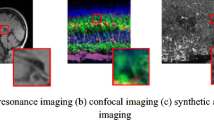Abstract
In this paper, we propose an image denoising algorithm for one special class of images which have periodical textures and contaminated by poisson noise using patch estimation and low patch-rank regularization. In order to form the data fidelity term, we take the patch-based poisson likelihood, which will effectively remove the ‘blurring’ effect. For the sparse prior, we use the low patch-rank as the regularization, avoiding the choosing of dictionary. Putting together the data fidelity and the prior terms, the denoising problem is formulated as the minimization of a maximum likehood objective functional involving three terms: the data fidelity term; a sparsity prior term, in the form of the low patch-rank regularization ;and a non-negativity constraint (as Poisson data are positive by definition). Experimental results show that the new method performs well for this special class of images which have periodical texture, and even for images with not strictly periodical textures.






Similar content being viewed by others
References
Besbeas P, Fies ID, Sapatinas T (2004) Comparative simulation study of wavelet shrinkage etimators for Poisson counts. Int Stat Rev 72:209–237
Chandrasekharan V, Sanghavi S, Parillo P, Wilsky A (2011) Rank-sparsity incoherence for matrix decomposition. SIAM J Optim 21(2):572–596
Combettes PL, Pesquet J (2007) A Douglas-Rachford splittting approach to nonsmooth convex variational signal recovery. IEEE J Sel Topics Signal Process 1(4):564–574
Dabov K, et al (2007) Image denoising by sparse 3-D transform-domain collaborative filtering. IEEE Trans Image Process 16(8):2080–2095
Donoho D (1993) Nonlinear wavelet methods for recovery of signals, densities and spectra from indirect and noisy data. In: Proceedings of symposia in applied mathematics: differentperspectives on wavelets, American Mathematical Society, pp 173–205
Dupe F-X, Fadili J, Starck J-L (2011) Deconvolution under Poisson noise using exact data fidelity and synthesis or analysis sparsity priors. arXiv:1103.2213v1
Elad M, Figueiredo MAT, Ma Y (2010) On the role of sparse and redundant representations in image processing. IEEE Proc - Special Issue on Applications of Sparse Representation and Compressive Sensing 98(6):972–982
Yin W, Hale E, Zhang Y (2008) Fixed-point continuation for L1-minimization: methodology and convergence. SIAM J Optim 19(3):1107–1130
Goldstein T, Osher S (2009) The split Bregman method for L1-regularized problems. SIAM J Imaging Sci 2(2):323–343
Green M (2002) Statistics of images, the TV algorithm of Rudin-Osher-Fatemi for image denoising and an improved denoising algorithm. CAM Report 02–55, UCLA
Jonsson E, Huang C-S, Chan T (1998) Total variation regularization in positron emission tomography. CAM Report 98–48, UCLA
Kervrann C, Trubuil A (2004) An adaptive window approach for poisson noise reduction and structure preserving in confocal microscopy. In: International Symposium on Biomedical Imaging (ISBI04), Arlington, VA
Kolaczyk E (1999) Wavelet shrinkage estimation of certain Poisson intensity signals using corrected thresholds. Statist Sinica 9:119–135
Markku M, Foi A (2011) Optimal inversion of the Anscombe transformation in low-count poisson image denoising. IEEE Trans Image Process 20(1):99–109
Rudin L, Osher S, Fatemi E (1992) Nonlinear total variation based noise removal algorithms. Phys D 60:259–268
Rudin LI, Osher S (1994) Total variation based image restoration with free local constraints. In: ICIP (1), pp 31–35
Schaeffer H, Osher S (2011) A low patch-rank interpretation of texture. ftp://ftp.math.ucla.edu/pub/camreport/cam11-75.pdf
Timmermann K, Novak R (1999) Multiscale modeling and estimation of Poisson processes with applications to photonlimited imaging. IEEE Trans Inform Theory 45:846–852
Wright J, Ganesh A, Rao S, Ma Y (2009) Robust principal component analysis: exact recovery of corrupted low-rank matrices via convex optimization. In: Proceedings of the Conference on Neural Information Processing Systems (NIPS)
Wright J, Ganesh A, Rao S, Ma Y (2011) Robust principal component analysis? J ACM 58(3),11:1–37
Wright J, Ma Y, Mairal J, Sapiro G, Huang T, Yan SC (2010) Sparse representation for computer vision and pattern recognition. Proc IEEE 98(6):1031–1044
Yin W, Osher S, Goldfarb D, Darbon J (2008) Bregman iterative algorithms for L1-minimization with applications to compressed sensing. SIAM J Imaging Sci 1:143–168
Author information
Authors and Affiliations
Corresponding authors
Additional information
This paper is supported by the National natural science foundation of China (No. 61262050,61232011), NSFC-Guangdong Joint Fund (No. U1201252, U1135003), Foundation of Jiangxi Educational Committee (No. GJJ12441), Natural Science Foundation of Jiangxi (20122BAB211003).
Rights and permissions
About this article
Cite this article
Li, B., Lin, G., Chen, Q. et al. Image denoising with patch estimation and low patch-rank regularization. Multimed Tools Appl 71, 485–495 (2014). https://doi.org/10.1007/s11042-013-1535-4
Published:
Issue Date:
DOI: https://doi.org/10.1007/s11042-013-1535-4




